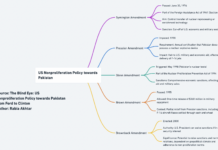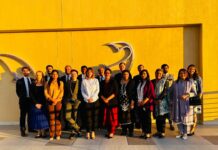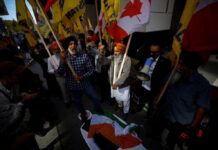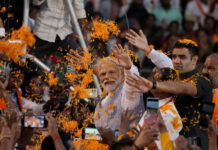Saima Aman Sial
India’s rapid drift towards extremism, as evidenced by the alarming rise of Hindu nationalism at home and irredentist proclivities in the region, poses a significant threat to not only that country’s social fabric but also regional stability. One prominent feature of the Bharatiya Janta Party’s (BJP) administration is its inclination towards infusing religious elements into various state ceremonies and symbols, as exemplified by the recent inauguration of the New Parliament House. During the event, Indian Prime Minister Narendra Modi partook in a ‘puja,’ a Hindu religious ritual, before entering the Parliament, accompanied by a procession of Hindu priests.
The placement of a mural in the new Parliament has been a subject of great controversy, especially among South Asian states, for it depicts a map of ancient India whose geographical area includes present-day Afghanistan, Pakistan, Maldives, Sri Lanka, Myanmar, and Bangladesh. Indian officials defended the mural by calling it a cultural map representing the idea of ‘responsible and people-oriented governance’. In reality, however, it is reflective of a mindset that entertains and believes in dangerous, grandiose ideas of expansionism.
Tellingly, the said building was inaugurated on the day Vinayak Damodar Savarkar, a leader of the Rashtriya Swayamsevak Sangh (RSS), a right-wing Hindu-nationalist organization and the mastermind of the ‘Hindutva’ radical political ideology, was born. The RSS, it must be stressed, believes in the ideology of Akhand Bharat (undivided India) and propagates the idea of the territorial unity of the Indian subcontinent, an area which includes present-day Pakistan and Bangladesh, under a unified Hindu-majority nation. Further, it employs radical means at home to achieve supremacy of Hindus, such as inciting religious intolerance, hate speech, and violence against religious minorities within India. The organization was banned thrice in India, starting in 1948, when its erstwhile member assassinated Mohandas Karamchand Gandhi.
Here, it is important to note that BJP’s policies are influenced and directed by RSS’ ideology. Indeed, the current Indian government retains strong links with the RSS, of which Prime Minister Modi himself is a lifetime member. A concrete manifestation of this nexus was through the enactment of the Citizens Amendments Act (CAA) in 2019. The Act makes it easier for non-Muslim immigrants from Afghanistan, Bangladesh, and Pakistan to get Indian citizenship. It also grants individuals of select non-Muslim communities in these countries refugee status within India and reserves the category of illegal migrant for Muslims alone. This Act continues to attract widespread international concern from the U.S. Commission on International Religious Freedom (USCIRF) and the Office of the United Nations High Commissioner for Human Rights(OHCHR). In its latest report released this May, USCIRF criticized the U.S. State Department for not including India in the list of Countries of Particular Concern (CPC) under the International Religious Freedom Act (IRFA).
Moreover, Modi’s desire of making India a state for Hindus has been expressed in several other changes in Indian state laws, not least the decision to strip 4 million Bengali Muslims in Assam of their citizenship under the highly controversial National Register of Citizens. In a so-called Hindu Rashtra (Hindu polity), as professed and pictured by RSS, the religious minorities, i.e. around 200 million Muslims and 30 million Christians, would be treated as second-class citizens and may have to forgo their citizenship. Already one can witness domestic laws to ban hijab in the state of Karnataka, as well as the ban on slaughtering cows in New Delhi, Gujarat, Haryana, Himachal Pradesh, Jammu and Kashmir, Punjab, Rajasthan, and elsewhere.
This religious persecution is depicted in its worst form in Indian Illegally Occupied Jammu and Kashmir(IIOJK). To implement its expansionist designs, the Indian government unilaterally abrogated Articles 370 and 35-A of the Indian constitution in August 2019, a unilateral act that was repugnant to all multilateral and bilateral commitments made apropos of the disputed territory. Article 370, while granting a special status to the region, exempted it from the Indian constitution. As for Article 35(A),it defined permanent and non-permanent residents, and secured, at least on paper, the rights of the Muslim majority in the state. The scrapping of Articles 370 and 35 (A) removed that special status and now allows for settlements by non-Kashmiris in the area, something which threatens to illegally change its demographics.
While announcing the revocation of Article 370 and 35 (A), Indian Home Minister Amit Shah categorically mentioned that, “Kashmir is an integral part of India, there is no doubt over it. When I talk about Jammu and Kashmir, Pakistan occupied Kashmir and Aksai Chin are included in it.” This mindset clearly shows an utter disregard for the United Nations Security Council (UNSC) resolutions on the Kashmir dispute, and therefore is a clear manifestation of India’s revisionist agenda, which threatens regional stability.
Pakistan, as the principal target of this agenda, is alive to the threats posed by this creeping project land-grab. The country’s Foreign Office spokesperson, while commenting on the mural controversy, stated that the Akhand Bharat ideology depicted India’s expansionist mindset. She urged that “India should stay away from expansionist ideology and come forward to settle disputes with its neighbouring countries in a peaceful manner.” However, what is more troublesome is that Indian hegemonic ambitions of dominating South Asia find cushion in the U.S. Indo-Pacific Strategy, which considers that country as the net security provider in the Indian Ocean Region (IOR) against China. This has resulted in unprecedented Indian military and strategic arms buildup, resulting in its ever-increasing intransigence towards conflict-resolution. The Hindu expansionism, depicted in the Akhand Bharat ideology, aided and abetted by arms induction from the West, portends negatively for South Asian security. This descent into ultra-nationalist extremism not only threatens India’s internal cohesion but also endangers regional and international peace.
Saima Aman Sial is Associate Senior Researcher, Centre for Aerospace and Security Studies (CASS), Lahore, Pakistan.

















